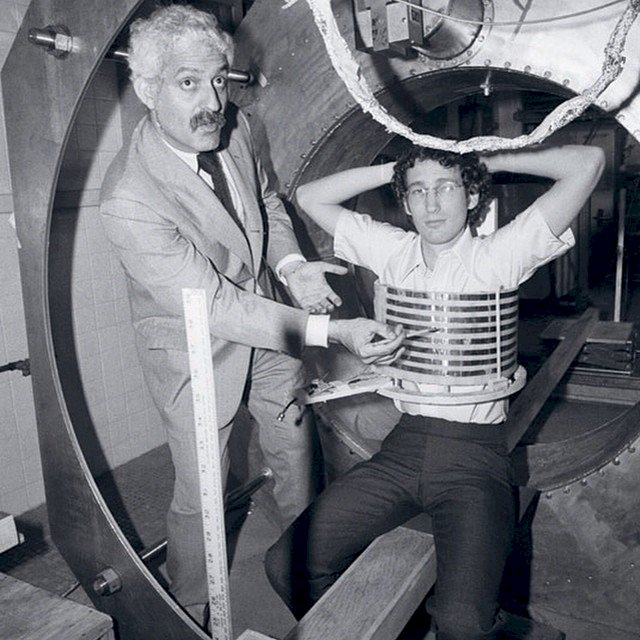History
Damadian was born into an Armenian-French family in New York. He graduated from the University of Wisconsin–Madison with a bachelor's degree in mathematics in 1956 and an M.D. from the Albert Einstein College of Medicine in New York City in 1960. He spent eight years at Juilliard studying violin and competing in Junior Davis Cup tennis tournaments. Raymond and his wife Donna married after a year he finished medical school, and the couple had three children. Raymond claims he was interested in cancer detection when he was ten years old, as he witnessed his maternal grandmother, with whom he had a close relationship, succumb to breast cancer.
Interests and Experiments
Damadian, a mathematician and scientific genius, then went on to become a doctor to cure cancer. Damadian's scientific interests prompted him to experiment with NMR technology, which involves exposing atomic nuclei to a magnetic field and causing the emission of radio waves at predictable frequencies.Damadian played a key role in adapting this technology for use on the human body, where it could identify aberrant tissue as a scanner. He offended potential investors and scientists researching NMR since he was "just" a physician, not a Ph.D., due to his unfriendly attitude. Damadian, on the other hand, persisted in his study and in his confidence that the technology might be useful in actual medicine.
Damadian Research
Damadian's study on sodium and potassium in live cells led to his initial nuclear magnetic resonance (NMR) tests, which led to his 1969 proposal for the MR body scanner.
Damadian found that malignant and normal tissue may be differentiated in vivo by nuclear magnetic resonance (NMR) due to their lengthy relaxation periods, either T1 (spin-lattice relaxation) or T2 (spin-spin relaxation). He and other researchers looked at the 1H NMR signals in cells independently and discovered that the relaxation periods were considerably shorter than in distilled water. This was compatible with adsorption onto macromolecular surfaces regulating a substantial portion of the water. Because of the disordering of malignant cells and their higher potassium levels, Damadian anticipated that cancerous cells would have prolonged relaxation periods since the potassium ions would be "structure-breaking" to the structured water fraction. In 1977, Damadian became the first person to do a whole-body scan on a human to identify cancer cells. Damadian developed the first nuclear magnetic resonance (N.M.R.) body scanner in July 1977 and made a significant contribution to the field of science and medicine.
Awards and Controversy
He acquired a patent for his Magnetic Resonance Imaging (M.R.I.) technology in 1974, and he completed the first successful body scan a few years later. Damadian had trouble getting research funding, maybe because he over-hyped his findings or because early M.R.I. scans were rudimentary. As a result, he moved into business, selling his first NMR scanner in 1980. In 1997, he won a $128.7 million judgment against General Electric for patent infringement. His firm, Fonar, had yearly revenues of $13 million at the time.
Herman Carr claimed to have created a one-dimensional magnetic resonance (MR) picture in the 1950s. From the University of Nottingham's Peter Mansfield then devised a mathematical approach that allowed scans to be completed in seconds instead of hours, resulting in sharper pictures than Lauterbur's. Damadian developed the first whole-body MRI scanner and generated the first full magnetic resonance imaging ("MRI") scan of the human body, whereas Lauterbur and Mansfield concentrated on animals and human limbs.
It took Damadian and his coworkers Larry Minkoff and Michael Goldsmith seven years to get to this stage. Though no systems would ever utilize Damadian's technique, they named their initial computer "Indomitable" to represent the spirit of their effort to achieve what many claimed could not be done. His imaging approach was never developed into a viable technology, and as a result, it has never been utilised in the current MRI.
Damadian has won several awards. Damadian received the Lemelson-MIT Prize Program's $100,000 Lifetime Achievement Award in 2001, honoring him as "the man who invented the MRI scanner." In 1988, Damadian was awarded the National Medal of Technology, and in 1989, he was elected into the National Inventors Hall of Fame. Paul Lauterbur and Sir Peter Mansfield received the Nobel Prize in Physiology or Medicine in 2003 for their work on magnetic resonance imaging. Although Nobel regulations enable up to three recipients to split the prize, Damadian did not receive it.
Damadian stated that credit should be given to "me, then Lauterbur," but Lauterbur believed that he should be the only one given credit. The National Academy of Sciences commissioned a chronology of MRI achievements in 1997, and Damadian was credited with four of the twelve in an early edition. None of the milestones had been reached at the time of the final release in 2001, which took longer than any other in the series. Damadian's approaches have "not proved clinically reliable in detecting or diagnosing cancer," according to the text. Damadian said in 2002, "If I had not been born, would MRI have existed? I don't think so. If Lauterbur had not been born? I would have gotten there. Damadian himself said, "Before this happened, nobody ever said to me 'They will not give you the Nobel Prize for Medicine because you are a creation scientist. If people were actively campaigning against me because of that, I never knew it."
The scanner is still used today to check soft tissue and diagnose a range of medical problems since it is safe and accurate. Damadian continues to improve the technology of the instrument and has received important accolades for his achievements while being denied a Nobel Prize share. The Smithsonian possesses his original M.R.I. machine.



 Local BangaloreTeam
Local BangaloreTeam 










